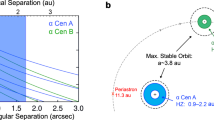Abstract
The transit of exoplanets across a stellar disk will often occur in GAIA observations. A safe detection of the slight dimming of the star can be made many hundred times, i.e. in cases where the star is sufficiently constant in intensity, and the photometry is very precise. When combined with the simultaneous GAIA astrometry or ground-based radial velocities the scientific harvest is orbit, mass and mass density for hundreds of exoplanets. We have typically considered Jupiter-size planets at Earth-like distances from the stars.
Similar content being viewed by others
References
Bienaymé O. and Turon C. (eds.): 2001, Gaia, a European space project, Proc. of the school in Les Houches, France, May 13–18, 2001, J. Phys. IV France, in press.
ESA: 2000, GAIA: 'Composition, Formation and Evolution of the Galaxy', Technical Report, ESA-SCI(2000)4.
Høg, E.: 2001, Photometric and imaging performance, in: O. Bienaymé and C. Turon (eds.), J. Phys. IV France, Gaia, a European Space Project, in press. Available as GAIA-CUO-091 at http://www.astro.ku.dk/~erik/gaia/91.
Author information
Authors and Affiliations
Rights and permissions
About this article
Cite this article
Høg, E. Detection of Extra-Solar Planets by GAIA Photometry. Astrophysics and Space Science 280, 139–142 (2002). https://doi.org/10.1023/A:1015587130229
Issue Date:
DOI: https://doi.org/10.1023/A:1015587130229




